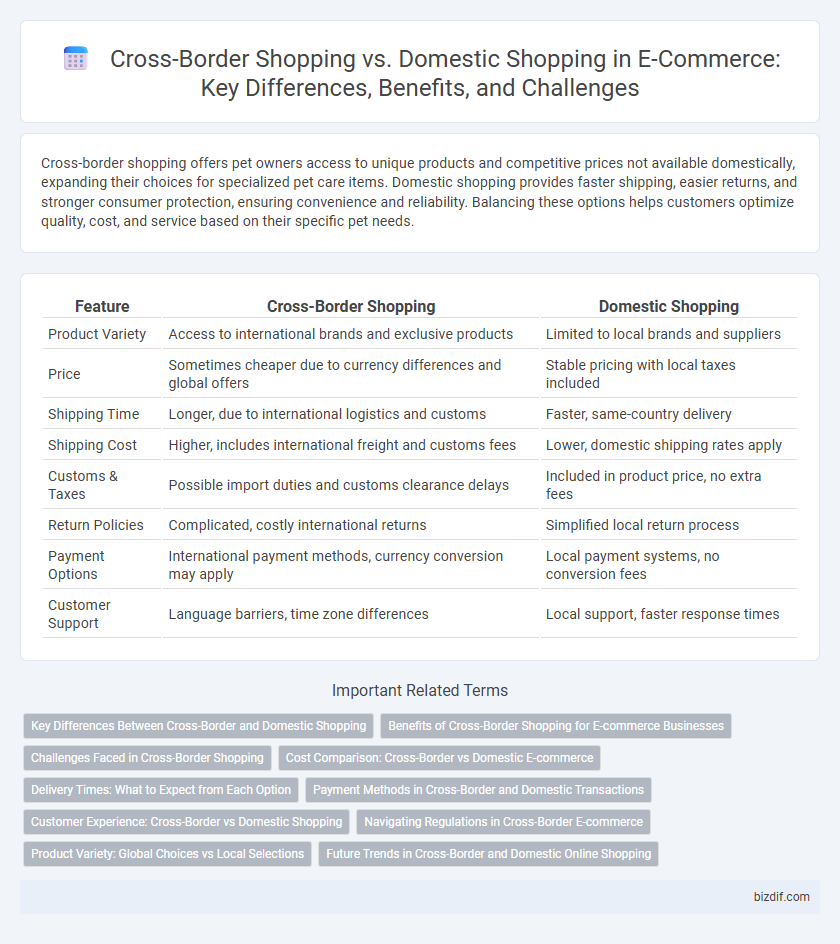Cross-border shopping offers pet owners access to unique products and competitive prices not available domestically, expanding their choices for specialized pet care items. Domestic shopping provides faster shipping, easier returns, and stronger consumer protection, ensuring convenience and reliability. Balancing these options helps customers optimize quality, cost, and service based on their specific pet needs.
Table of Comparison
| Feature | Cross-Border Shopping | Domestic Shopping |
|---|---|---|
| Product Variety | Access to international brands and exclusive products | Limited to local brands and suppliers |
| Price | Sometimes cheaper due to currency differences and global offers | Stable pricing with local taxes included |
| Shipping Time | Longer, due to international logistics and customs | Faster, same-country delivery |
| Shipping Cost | Higher, includes international freight and customs fees | Lower, domestic shipping rates apply |
| Customs & Taxes | Possible import duties and customs clearance delays | Included in product price, no extra fees |
| Return Policies | Complicated, costly international returns | Simplified local return process |
| Payment Options | International payment methods, currency conversion may apply | Local payment systems, no conversion fees |
| Customer Support | Language barriers, time zone differences | Local support, faster response times |
Key Differences Between Cross-Border and Domestic Shopping
Cross-border shopping involves purchasing goods from international sellers, often leading to higher shipping costs, longer delivery times, and potential customs duties compared to domestic shopping, which typically offers faster delivery and lower shipping expenses. Currency exchange rates and varying return policies further distinguish cross-border transactions from domestic ones, impacting buyer confidence and total purchase cost. Understanding these differences helps consumers optimize their shopping choices based on cost, convenience, and product availability.
Benefits of Cross-Border Shopping for E-commerce Businesses
Cross-border shopping expands e-commerce businesses' reach to global markets, increasing customer base and revenue potential significantly. Access to international consumers enables diversification of sales channels, reducing dependence on domestic market fluctuations and improving overall business resilience. Leveraging cross-border logistics and localized marketing strategies enhances brand visibility and customer engagement, driving higher conversion rates and customer loyalty worldwide.
Challenges Faced in Cross-Border Shopping
Cross-border shopping in e-commerce often involves challenges such as higher shipping costs, longer delivery times, and complex customs regulations that can deter customers. Currency exchange fluctuations and language barriers further complicate the purchasing process, impacting user satisfaction and trust. Returns and warranty claims also become more difficult to manage compared to domestic shopping, adding to operational hurdles for online retailers.
Cost Comparison: Cross-Border vs Domestic E-commerce
Cross-border e-commerce often involves higher costs due to international shipping fees, customs duties, and currency exchange rates, which can increase the total purchase price compared to domestic shopping. Domestic e-commerce typically offers lower shipping costs and faster delivery times, reducing the overall expense for consumers. Price transparency and tax regulations also vary significantly, influencing the cost-effectiveness of cross-border versus domestic online shopping.
Delivery Times: What to Expect from Each Option
Cross-border shopping typically involves longer delivery times compared to domestic shopping due to international shipping logistics, customs clearance, and potential delays at borders. Domestic shopping offers faster delivery, often within a few days, leveraging local distribution networks and streamlined shipping processes. Understanding these differences helps consumers set realistic expectations for order arrival and plan their purchases accordingly.
Payment Methods in Cross-Border and Domestic Transactions
Cross-border shopping often involves diverse payment methods including international credit cards, PayPal, and localized digital wallets to accommodate currency conversion and reduce transaction fees. Domestic transactions primarily rely on familiar, region-specific methods such as debit cards, bank transfers, and mobile payment apps optimized for local currencies and compliance with national regulations. Understanding these payment variations is crucial for e-commerce platforms to enhance user experience and reduce cart abandonment in both cross-border and domestic sales.
Customer Experience: Cross-Border vs Domestic Shopping
Cross-border shopping often involves longer delivery times, potential customs fees, and language barriers, which can complicate the customer experience compared to domestic shopping. Domestic shopping typically offers faster shipping, easier returns, and clearer communication, enhancing convenience and trust for consumers. Customers prioritize seamless transactions, and localized services in domestic e-commerce generally lead to higher satisfaction rates.
Navigating Regulations in Cross-Border E-commerce
Navigating regulations in cross-border e-commerce involves understanding import duties, customs clearance procedures, and country-specific legal requirements, which can significantly impact delivery times and costs. Compliance with data protection laws such as GDPR and consumer protection regulations is essential to avoid penalties and ensure trust in international transactions. Leveraging localized payment gateways and adapting to varying tax regimes, including VAT and GST, enhances the efficiency and legality of cross-border shopping compared to domestic e-commerce operations.
Product Variety: Global Choices vs Local Selections
Cross-border shopping offers consumers access to a wider product variety, including international brands and unique items unavailable in local markets. Domestic shopping typically provides limited selections concentrated on regional preferences and readily available inventory. Access to global options enhances consumer choice but may involve longer delivery times and higher costs compared to immediate purchase from local retailers.
Future Trends in Cross-Border and Domestic Online Shopping
Cross-border online shopping is projected to grow at a CAGR of 25% by 2030, driven by advancements in global payment solutions and localized delivery logistics. Domestic e-commerce markets will emphasize hyper-localization through AI-driven personalized experiences and faster last-mile delivery, enhancing customer retention. Integration of blockchain for secure transactions and augmented reality for product visualization will shape the future landscape of both cross-border and domestic online shopping ecosystems.
Cross-border shopping vs Domestic shopping Infographic

 bizdif.com
bizdif.com